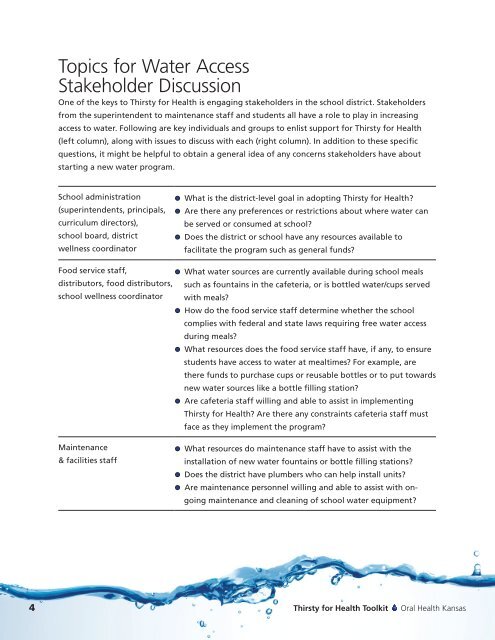Thirsty for Health Toolkit
Create successful ePaper yourself
Turn your PDF publications into a flip-book with our unique Google optimized e-Paper software.
Topics <strong>for</strong> Water Access<br />
Stakeholder Discussion<br />
One of the keys to <strong>Thirsty</strong> <strong>for</strong> <strong>Health</strong> is engaging stakeholders in the school district. Stakeholders<br />
from the superintendent to maintenance staff and students all have a role to play in increasing<br />
access to water. Following are key individuals and groups to enlist support <strong>for</strong> <strong>Thirsty</strong> <strong>for</strong> <strong>Health</strong><br />
(left column), along with issues to discuss with each (right column). In addition to these specific<br />
questions, it might be helpful to obtain a general idea of any concerns stakeholders have about<br />
starting a new water program.<br />
School administration<br />
(superintendents, principals,<br />
curriculum directors),<br />
school board, district<br />
wellness coordinator<br />
• What is the district-level goal in adopting <strong>Thirsty</strong> <strong>for</strong> <strong>Health</strong>?<br />
• Are there any preferences or restrictions about where water can<br />
be served or consumed at school?<br />
• Does the district or school have any resources available to<br />
facilitate the program such as general funds?<br />
Food service staff, • What water sources are currently available during school meals<br />
distributors, food distributors, such as fountains in the cafeteria, or is bottled water/cups served<br />
school wellness coordinator with meals?<br />
• How do the food service staff determine whether the school<br />
complies with federal and state laws requiring free water access<br />
during meals?<br />
• What resources does the food service staff have, if any, to ensure<br />
students have access to water at mealtimes? For example, are<br />
there funds to purchase cups or reusable bottles or to put towards<br />
new water sources like a bottle filling station?<br />
• Are cafeteria staff willing and able to assist in implementing<br />
<strong>Thirsty</strong> <strong>for</strong> <strong>Health</strong>? Are there any constraints cafeteria staff must<br />
face as they implement the program?<br />
Maintenance<br />
& facilities staff<br />
• What resources do maintenance staff have to assist with the<br />
installation of new water fountains or bottle filling stations?<br />
• Does the district have plumbers who can help install units?<br />
• Are maintenance personnel willing and able to assist with ongoing<br />
maintenance and cleaning of school water equipment?<br />
4<br />
<strong>Thirsty</strong> <strong>for</strong> <strong>Health</strong> <strong>Toolkit</strong><br />
Oral <strong>Health</strong> Kansas








